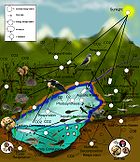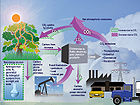- Microbial intelligence
-
Microbial intelligence (popularly known as bacterial intelligence) is the intelligence shown by microorganisms. The concept encompasses complex adaptive behaviour shown by single cells, and altruistic and/or cooperative behavior in populations of like or unlike cells mediated by chemical signalling that induces physiological or behavioral changes in cells and influences colony structures.
Complex cells, like protozoa or algae, show remarkable abilities to organise themselves in changing circumstances [1]. Shell-building by amoebae, reveals complex discrimination and manipulative skills that are ordinarily thought to occur only in multicellular organisms.
Even bacteria, which show primitive behavior as isolated cells, can display more sophisticated behavior as a population. These behaviors occur in single species populations, or mixed species populations. Examples are colonies of Myxobacteria, quorum sensing, and biofilms.
It has been suggested that a bacterial colony loosely mimics a biological neural network. The bacteria can take inputs in form of chemical signals, process them and then produce output chemicals to signal other bacteria in the colony.
The mechanisms that enable single celled organisms to coordinate in populations presumably carried over in those lines that evolved multicellularity, and were co-opted as mechanisms to coordinate multicellular organisms.
Contents
Examples of microbial intelligence
- The formation of biofilms requires joint decision by the whole colony.
- Under nutritional stress bacterial colonies can organise themselves in such a way so as to maximise nutrient availability.
- Bacteria reorganise themselves under antibiotic stress.
- Bacteria can swap genes (such as genes coding antibiotic resistance) between members of mixed species colonies.
- Individual cells of myxobacteria and cellular slime moulds coordinate to produce complex structures or move as multicellular entities.
- Populations of bacteria use quorum sensing to judge their own densities and change their behaviors accordingly. This occurs in the formation of biofilms, infectious disease processes, and the light organs of bobtail squid.
- It's known that for any bacterium to enter a host's cell, the cell must display receptors to which bacteria can adhere and be able to enter the cell. Some strains of E. coli are able to internalize themselves into a host's cell even without the presence of specific receptors as they bring their own receptor to which they then attach and enter the cell.
- Under rough circumstances, some bacteria transform into endospores to resist heat and dehydration.
- A huge array of microorganisms have the ability to overcome being recognized by the immune system as they change their surface antigens so that any defense mechanisms directed against previously present antigens are now useless with the newly expressed ones.
See also
- Swarm intelligence
- Collective intelligence
- Synthetic biology
- Biopunk
- Biotechnology
- Genetic engineering
References
- Eshel Ben-Jacob (1998). Bacterial wisdom, Godel's theorem and creative genomic webs. http://star.tau.ac.il/~eshel/list.html.
- Brian J. Ford (2004). Are cells ingenious?. http://www.brianjford.com/04-12-ingens.pdf.
- Eshel Ben-Jacob, I. Becker, Y. Shapira (2004). Bacterial Linguistic Communication and Social Intelligence. http://star.tau.ac.il/~eshel/bacterial_linguistic.html.
- Brian J. Ford (2006). Revealing the ingenuity of the living cell. http://www.brianjford.com/06-07-ingenious-biologist.pdf.
- Anthea Lipsett (2006). Not so clever, are you?. http://www.brianjford.com/06-09.HTM.
- Brian J. Ford (2010). Secret Intelligence of the Living Cell. http://brianjford.com/a-10-NSc-single_cell.pdf.
External links
- BT ponders bacterial intelligence
- Eshel Ben-Jacob's Homepage
- Realizing Social Intelligence of Bacteria
- Intelligent Bacteria?
- Microbial Intelligence Blog
- Making a conscious decision making computer out of bacteria to overcome limitations of Turing theorem
Swarming Swarm algorithms - Agent-based models
- Ant colony optimization
- Ant robotics
- Artificial Ants
- Bees algorithm
- Bee colony optimization
- Boids
- Crowd simulation
- Firefly algorithm
- Glowworm swarm optimization
- Particle swarm optimization
- Self-propelled particles
- Swarm intelligence
- Swarm (simulation)

Biological swarming - Agent-based model in biology
- Bait ball
- Collective animal behavior
- Feeding frenzy
- Flock
- Flocking
- Herd
- Herd behavior
- Mixed-species foraging flock
- Mobbing behavior
- Pack hunter
- Patterns of self-organization in ants
- Sardine run
- Shoaling and schooling
- Sort sol
- Swarming behaviour
- Swarming (honey bee)
- Swarming motility
Animal migration Swarm robotics Related topics Categories:
Wikimedia Foundation. 2010.


